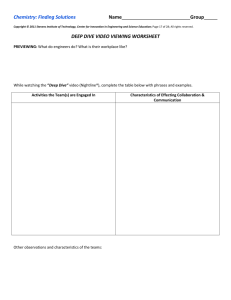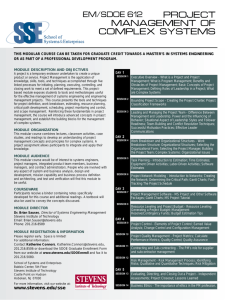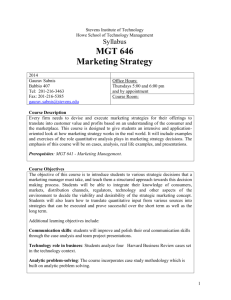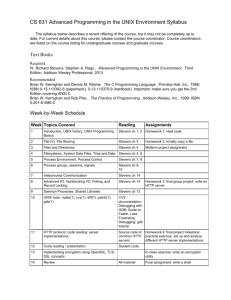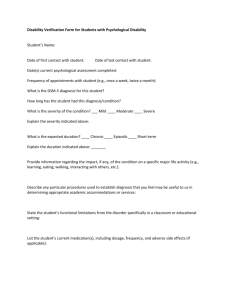Multimedia Learning Environments for Virtual Experiential
advertisement
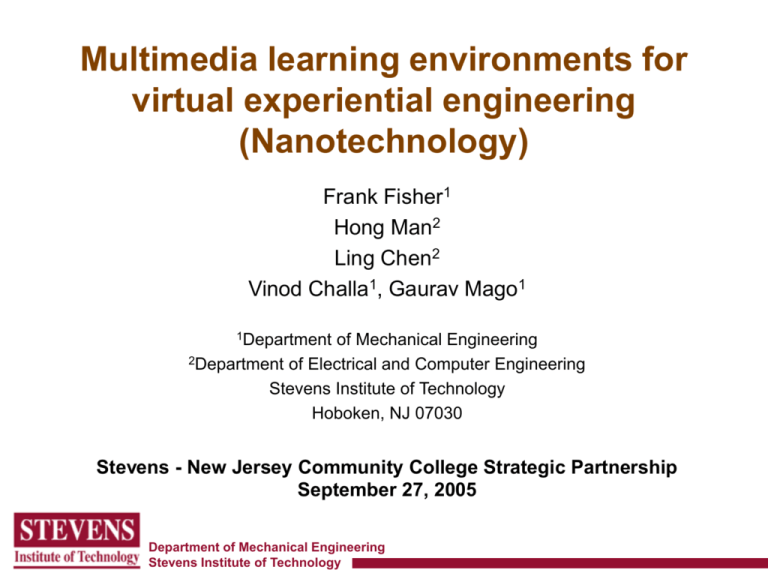
Multimedia learning environments for virtual experiential engineering (Nanotechnology) Frank Fisher1 Hong Man2 Ling Chen2 Vinod Challa1, Gaurav Mago1 1Department of Mechanical Engineering 2Department of Electrical and Computer Engineering Stevens Institute of Technology Hoboken, NJ 07030 Stevens - New Jersey Community College Strategic Partnership September 27, 2005 Department of Mechanical Engineering Stevens Institute of Technology Motivation • Consider a standard S-curve “adaptation of technology” curve and the use of computer technology in education • How will students learn is 10 years? In 20 years? In 50 years? Impact • Leveraging multimedia capabilities for educational design Time • Email • Powerpoint • Webpages • Course software • Course specific applets • drilling modules • Course administration - drilling - student learning Department of Mechanical Engineering Stevens Institute of Technology Use of multimedia • Case-based learning used in other pre-professional fields (law, medicine, education) • multimedia technology now provides the opportunity to bring the practice of authentic engineering into the classroom! Department of Mechanical Engineering Stevens Institute of Technology Introduction • Design, develop, and demonstrate a flexible multimedia-based environment based on the video documentation of authentic engineering practice to be incorporated into the undergraduate • Potential learning environments enabled via multimedia technology: Virtual Research E xperiences for Und ergraduates in Nanotechnology (VREUN) [this to link VREUN1] Couched in the Stevens culture of Technogenesis, each VREUN module will introduce undergraduate students to concepts of nanotechnology in the context of active research being conducted on camp us. Under faculty supervision, these learning modules will be developed by, and document the research efforts of, freshmen and sophomo re engineering students contributing to nanotechnology research in these labs, and focus on the nanoscale p henomena being investigated, key research questions raised and how they are being addressed in the lab, and how this understanding is necessary for ultimate realization in the marketplace. Virtual Lab Tours [this to link Virt_Lab_tour] Multimedia technology now brings tours of the faculty research labs to your computer. Virtual Graduate Research and Dissemination (VG RAD) [this to link VGrad] Multimedia educational modules based on graduate research being done at Stevens. Virtual Senior Design Projects (V-Senior-D) [this to link VSeniorD From initial design to prototype completion and testing, follow the progress of these Senior Design projects conducted by undergraduates at Stevens. VREUN • Virtual Research Experiences in Nanotechnology • New NSF-funded project (September 2005) • 6 Nanotechnology faculty at Stevens, 1 ECE faculty at Stevens (multimedia), CIESE Proj ect title: Characterization and Modeling of Nanotube -Reinfo rced Poly mers Investigator: Frank Fis her, Department of Mechan ical Eng ineering Proj ect Title: Fabrication of Au N ano- Shells for Surface-Enhanced Raman Scattering Investigators: Henry Du, Depa rtment of Chemi cal, Biome dical, and Materials Engin eering; Svetlana Sukhis hvi li, Department of Chemist ry and Chemi cal Biology Proj ect Title: Multi-S cale Materials Property Prediction Investigator: Kishore Pochir aju, Department of Mechanical Enginee ring Proj ect Title: Piezo electric Nano fibers: Deve lopment and Char acteriz ation Investigator: Yong Shi, Department of Mechan ical Engin eering Proj ect Title: PEG-based Hyd roge ls Investigator: Matthew Libera, Department of Chemical, Biomedical, and Materials Engin eering VREUN Goal: Introduce concepts of nanotechnology and tie into core engineering fundamentals within the context faculty research couched in the spirit of Technogenesis Learning environment interface (version 0.1) Frame-based environment Much smaller constant header Dynamic sequencing More interesting video! Text box video-sensitive text/images/links related to discussion within clip Talking head Module Navigation (non-linear progression) Department of Mechanical Engineering Stevens Institute of Technology Email a question to Prof. Fisher Help? Virtual research experiences More detailed information (content) than in lab tours Connect research project with larger picture Approach of the research projects; uncertainty Vibration based Micropower Generation Focus on u-grad participation Window into research Importance, Background Work Techniques, Issues involved. Comparison of Different Techniques & choosing environment Novel Design, Modeling, Justification Tie research to education Proto-Type fabrication & Testing, as proof of Concept Realization of process flow for MEMS scale fabrication Possible Issues that could be encountered, How to deal Evaluation will be critical: Usability, scaffolding, etc Microfabrication & Testing of the device. Packaging & re-testing of the device. Department of Mechanical Engineering Stevens Institute of Technology Advantages of a multimedia based format • Video documentation provides the motivation and indexing for students to learn engineering “content” material • Video supplemented with content information (text, audio,etc) • Provides students: 1. Window into practice of engineering 2. See type of ill-defined problems common in practice of engineering 3. Framework of how engineering education relatesto real-world engineering (Why am I learning this?) 4. Benefits recognized of co-ops, internships, etc (can we package and incorporate into curriculum) Department of Mechanical Engineering Stevens Institute of Technology End with a story… • Brooke, starting at Stevens in Fall, in lab for 2 weeks • Explanation of my research… – What is a composite? - What is a polymer? – What is modulus? - What is strength? – What is a nanometer? – Why are carbon nanotubes so promising? – What could they be used for? …. Department of Mechanical Engineering Stevens Institute of Technology Extra slides Department of Mechanical Engineering Stevens Institute of Technology Work in progress • Objectives: – Design the format/layout for for the learning environment – Design author interface mechanism (WebCT) for adding material (author mode) – Develop modules based on two Fisher research projects – Develop additional multimedia lab tours • Interface mechanism: – Straightforward to upload video, text, audio, etc and edit module – Dynamic website so that both module and TOC updated – CD vs. online distribution; browser compatibility; OS (Windows vs Mac) – Database design, communication protocols, and content organization • Research Project documentation – Audio/video collection of sufficient quality – Multimedia editing (video, audio) – Organization – Clarity of information and level-appropriateness Multimedia interface - front page Work-in-progress Placeholders for now; better content later Author mode login Front page introduction/navigation Continue to labs Department of Mechanical Engineering Stevens Institute of Technology Environment main page Main page for grouping of modules: “virtual lab tours”, VREUN, etc Virtual lab tours currently available: ME CBME -Nanomechanics/materials (Fisher) - Lab 1 (Prof) -Lab 2 (Prof) - Lab 2 (Prof) ECE -Multimedia Lab (Man) -Lab 2 (Prof) Select lab from above menu Department of Mechanical Engineering Stevens Institute of Technology Multimedia learning environments for virtual experiential engineering and incorporation into the undergraduate curriculum Frank Fisher, ME Hong Man, ECE RIEE meeting May 27, 2005 Department of Mechanical Engineering Stevens Institute of Technology Introduction • design, develop, and demonstrate a flexible multimediabased learning environment • facilitate the deployment of modules based on the video documentation of engineering practice to be incorporated into the undergraduate curriculum • Virtual Co-op, Virtual Internship, Virtual REU Department of Mechanical Engineering Stevens Institute of Technology
